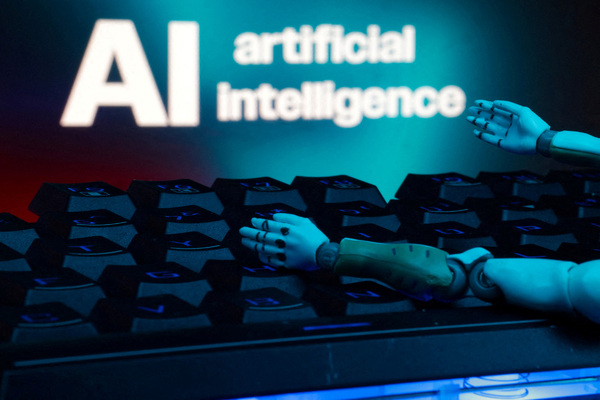Driving the use of AI tools

Dan Thomson at Sensay argues that employees need AI tools they can actually use
Despite the hype, the adoption of AI in the workplace has so far been a slow and piecemeal process. While employers are biting their nails in anticipation of AI’s expected productivity gains, frequent and habitual AI use remains low among employees – suggesting that they’re yet to buy into the promised future of AI-assisted workplaces.
Time and again, C-suite executives have cited AI implementation as a key business priority. And yet, the rates of AI adoption throughout the workforce are pretty unremarkable.
A recent study from Gallup found that two-thirds of employees say they never use AI in their work. Meanwhile, where employees have jumped on the AI bandwagon, their use of AI tools seems sporadic at best, with the majority stating they use it every now and then – every few months, or a couple of times a year.
Firms aren’t oblivious to this problem, but I think many of them are going about addressing it in the wrong way. Too many employers are turning to elaborate and resource-intensive upskilling programs, placing a burden on employees to pick up the slack where AI tools fall short.
To achieve widespread AI adoption across all tiers of the workforce, regardless of age, background, and experience, firms need to opt for AI tools with high levels of usability. And to find the perfect tool for their workforce, they must implement robust and inclusive product trials.
As AI continues to evolve, and AI tools become more complex, the learning curve grows steeper, slowing the pace of adoption. With AI forecasted to increase global corporate profits by up to $4.4 trillion a year, businesses can’t afford to lose out on AI’s potential gains – so they make a beeline for long-winded, time-consuming upskilling initiatives.
That’s not to say there aren’t benefits to upskilling – there are plenty. All good businesses strive to cultivate a culture of continued learning and development, and this is more relevant in the age of rapid technological development than ever.
But in the process, firms are glazing over the inherent usability and accessibility concerns of workplace AI tools, thrusting them on employees with the promise of staff training at a later date. And with this, AI adoption immediately reaches a roadblock.
The all-in focus on AI-centric skills and experience is a move that risks isolating older, less tech-savvy employees, among which AI adoption rates are the lowest. And with the average workplace more multi-generational than ever, businesses can’t afford to ostracize a whole chunk of their workforce.
Firms shouldn’t be aiming to merely teach employees how and where to use AI tools. They should be looking for platforms that enable staff to leverage their own skills; they need tools that employees not only feel confident using AI in their daily work, but empowered and motivated to. And that means finding and implementing AI tools that are navigable and usable from the very get-go – no intensive training or upskilling required.
Robust product trials are the first step towards finding the ideal, user-first AI tools for employees. But instead of pawning the responsibility off to the IT department, employees from across all stretches of the company need to be involved. During the trial, they need to be given the opportunity to use the AI tool in a real-world setting, allowing them to identify any problems or difficult-to-use features and offer their honest feedback.
Product trials should have measurable, standardised metrics. And they should be recorded by watching employees use a tool, and via feedback forms and interviews. How long does it take an employee to find a certain feature, for example? How would an employee rate their ability to navigate the platform, and how confident do they feel using it?
Ideally, employees should also have the chance to trial a variety of tools, allowing them to compare and contrast and figure out whether a given interface or platform style best suits the work they do. A chatbot application might be ideal for creative professionals or those trying to generate new ideas – but it might not be so helpful for someone from accounting.
A robust product trial will reveal any flaws, placing IT leaders in the position to make a well-informed decision about how best to mitigate these issues. Minor, fixable flaws like a UX quirk should be brought to the developer’s attention. If there’s the scope for future updates to improve employee user experience, then business leaders should push back on AI providers to implement those changes.
But more fundamental flaws, be it a user-hostile interface or incompatibility with key workplace software, should be met with the decision to look elsewhere for AI software – even if it means missing out on promised productivity gains.
The message to business leaders and IT professionals is this: make sure your employees are at the heart of all AI-related decisions – alongside profit and productivity. Any potential gains or improved margins will boil down to nothing if employees cannot or refuse to use a given AI tool.
While upskilling has its place, it shouldn’t make up the foundations of a corporate AI strategy. Employees shouldn’t have to change shape to fit around AI; business leaders need to find AI tools that slide into place in their firm’s pre-existing talent structure.
Dan Thomson is founder and CEO of Sensay, a startup building AI-powered employee digital clones for corporates
Main image courtesy of iStockPhoto.com and da-kuk

Business Reporter Team
Most Viewed
Winston House, 3rd Floor, Units 306-309, 2-4 Dollis Park, London, N3 1HF
23-29 Hendon Lane, London, N3 1RT
020 8349 4363
© 2025, Lyonsdown Limited. Business Reporter® is a registered trademark of Lyonsdown Ltd. VAT registration number: 830519543





